[English] 日本語
 Yorodumi
Yorodumi- PDB-3j92: Structure and assembly pathway of the ribosome quality control complex -
+ Open data
Open data
- Basic information
Basic information
| Entry | Database: PDB / ID: 3j92 | ||||||
|---|---|---|---|---|---|---|---|
| Title | Structure and assembly pathway of the ribosome quality control complex | ||||||
 Components Components |
| ||||||
 Keywords Keywords | RIBOSOME/LIGASE / RWD / RING /  quality control / RIBOSOME-LIGASE complex quality control / RIBOSOME-LIGASE complex | ||||||
| Function / homology |  Function and homology information Function and homology informationalpha-aminoacyl-tRNA binding / CAT tailing / RQC complex /  nuclear export / ribosome-associated ubiquitin-dependent protein catabolic process / nuclear export / ribosome-associated ubiquitin-dependent protein catabolic process /  ribosomal large subunit binding / protein autoubiquitination / rescue of stalled ribosome / cytosolic ribosome / RING-type E3 ubiquitin transferase ...alpha-aminoacyl-tRNA binding / CAT tailing / RQC complex / ribosomal large subunit binding / protein autoubiquitination / rescue of stalled ribosome / cytosolic ribosome / RING-type E3 ubiquitin transferase ...alpha-aminoacyl-tRNA binding / CAT tailing / RQC complex /  nuclear export / ribosome-associated ubiquitin-dependent protein catabolic process / nuclear export / ribosome-associated ubiquitin-dependent protein catabolic process /  ribosomal large subunit binding / protein autoubiquitination / rescue of stalled ribosome / cytosolic ribosome / RING-type E3 ubiquitin transferase / ribosomal large subunit binding / protein autoubiquitination / rescue of stalled ribosome / cytosolic ribosome / RING-type E3 ubiquitin transferase /  ubiquitin protein ligase activity / Antigen processing: Ubiquitination & Proteasome degradation / protein-containing complex assembly / ubiquitin protein ligase activity / Antigen processing: Ubiquitination & Proteasome degradation / protein-containing complex assembly /  tRNA binding / zinc ion binding / tRNA binding / zinc ion binding /  nucleus / nucleus /  cytosol cytosolSimilarity search - Function | ||||||
| Biological species |   Homo sapiens (human) Homo sapiens (human)  Oryctolagus cuniculus (rabbit) Oryctolagus cuniculus (rabbit)  Sus scrofa (pig) Sus scrofa (pig) | ||||||
| Method |  ELECTRON MICROSCOPY / ELECTRON MICROSCOPY /  single particle reconstruction / single particle reconstruction /  cryo EM / Resolution: 3.6 Å cryo EM / Resolution: 3.6 Å | ||||||
 Authors Authors | Shao, S. / Brown, A. / Santhanam, B. / Hegde, R.S. | ||||||
 Citation Citation |  Journal: Mol Cell / Year: 2015 Journal: Mol Cell / Year: 2015Title: Structure and assembly pathway of the ribosome quality control complex. Authors: Sichen Shao / Alan Brown / Balaji Santhanam / Ramanujan S Hegde /  Abstract: During ribosome-associated quality control, stalled ribosomes are split into subunits and the 60S-housed nascent polypeptides are poly-ubiquitinated by Listerin. How this low-abundance ubiquitin ...During ribosome-associated quality control, stalled ribosomes are split into subunits and the 60S-housed nascent polypeptides are poly-ubiquitinated by Listerin. How this low-abundance ubiquitin ligase targets rare stall-generated 60S among numerous empty 60S is unknown. Here, we show that Listerin specificity for nascent chain-60S complexes depends on nuclear export mediator factor (NEMF). The 3.6 Å cryo-EM structure of a nascent chain-containing 60S-Listerin-NEMF complex revealed that NEMF makes multiple simultaneous contacts with 60S and peptidyl-tRNA to sense nascent chain occupancy. Structural and mutational analyses showed that ribosome-bound NEMF recruits and stabilizes Listerin's N-terminal domain, while Listerin's C-terminal RWD domain directly contacts the ribosome to position the adjacent ligase domain near the nascent polypeptide exit tunnel. Thus, highly specific nascent chain targeting by Listerin is imparted by the avidity gained from a multivalent network of context-specific individually weak interactions, highlighting a new principle of client recognition during protein quality control. | ||||||
| History |
|
- Structure visualization
Structure visualization
| Movie |
 Movie viewer Movie viewer |
|---|---|
| Structure viewer | Molecule:  Molmil Molmil Jmol/JSmol Jmol/JSmol |
- Downloads & links
Downloads & links
- Download
Download
| PDBx/mmCIF format |  3j92.cif.gz 3j92.cif.gz | 3.6 MB | Display |  PDBx/mmCIF format PDBx/mmCIF format |
|---|---|---|---|---|
| PDB format |  pdb3j92.ent.gz pdb3j92.ent.gz | Display |  PDB format PDB format | |
| PDBx/mmJSON format |  3j92.json.gz 3j92.json.gz | Tree view |  PDBx/mmJSON format PDBx/mmJSON format | |
| Others |  Other downloads Other downloads |
-Validation report
| Arichive directory |  https://data.pdbj.org/pub/pdb/validation_reports/j9/3j92 https://data.pdbj.org/pub/pdb/validation_reports/j9/3j92 ftp://data.pdbj.org/pub/pdb/validation_reports/j9/3j92 ftp://data.pdbj.org/pub/pdb/validation_reports/j9/3j92 | HTTPS FTP |
|---|
-Related structure data
| Related structure data |  2832MC M: map data used to model this data C: citing same article ( |
|---|---|
| Similar structure data |
- Links
Links
- Assembly
Assembly
| Deposited unit | 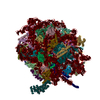
|
|---|---|
| 1 |
|
- Components
Components
+Protein , 47 types, 51 molecules ABCDEFGHIJLMNOPQRSTUVWXYZabcde...
-RNA chain , 4 types, 4 molecules 2578
| #48: RNA chain |  Transfer RNA Transfer RNAMass: 24816.811 Da / Num. of mol.: 1 / Source method: isolated from a natural source / Source: (natural)   Sus scrofa (pig) Sus scrofa (pig) |
|---|---|
| #49: RNA chain |  28S ribosomal RNA 28S ribosomal RNAMass: 1187230.000 Da / Num. of mol.: 1 / Source method: isolated from a natural source / Source: (natural)   Oryctolagus cuniculus (rabbit) Oryctolagus cuniculus (rabbit) |
| #50: RNA chain |  5S ribosomal RNA 5S ribosomal RNAMass: 38691.914 Da / Num. of mol.: 1 / Source method: isolated from a natural source / Source: (natural)   Oryctolagus cuniculus (rabbit) Oryctolagus cuniculus (rabbit) |
| #51: RNA chain |  5.8S ribosomal RNA 5.8S ribosomal RNAMass: 50143.648 Da / Num. of mol.: 1 / Source method: isolated from a natural source / Source: (natural)   Oryctolagus cuniculus (rabbit) Oryctolagus cuniculus (rabbit) |
-Non-polymers , 2 types, 164 molecules 


| #52: Chemical | ChemComp-MG / #53: Chemical | ChemComp-ZN / |
|---|
-Details
| Sequence details | ALTHOUGH ONLY ONE INSTANCE EACH OF PROTEINS NEMF AND LISTERIN IS PRESENT WITHIN THE COMPLEX, EACH ...ALTHOUGH ONLY ONE INSTANCE EACH OF PROTEINS NEMF AND LISTERIN IS PRESENT WITHIN THE COMPLEX, EACH OF THESE PROTEINS IS REPRESENTE |
|---|
-Experimental details
-Experiment
| Experiment | Method:  ELECTRON MICROSCOPY ELECTRON MICROSCOPY |
|---|---|
| EM experiment | Aggregation state: PARTICLE / 3D reconstruction method:  single particle reconstruction single particle reconstruction |
- Sample preparation
Sample preparation
| Component |
| ||||||||||||||||||||||||||||
|---|---|---|---|---|---|---|---|---|---|---|---|---|---|---|---|---|---|---|---|---|---|---|---|---|---|---|---|---|---|
| Buffer solution | Name: 50 mM HEPES, 100 mM potassium acetate, 5 mM magnesium acetate, 1 mM DTT pH: 7.4 Details: 50 mM HEPES, 100 mM potassium acetate, 5 mM magnesium acetate, 1 mM DTT | ||||||||||||||||||||||||||||
| Specimen | Conc.: 0.3 mg/ml / Embedding applied: NO / Shadowing applied: NO / Staining applied : NO / Vitrification applied : NO / Vitrification applied : YES : YES | ||||||||||||||||||||||||||||
| Specimen support | Details: Quantifoil R2/2 on 400 mesh Cu grid with thin carbon support | ||||||||||||||||||||||||||||
Vitrification | Instrument: FEI VITROBOT MARK I / Cryogen name: ETHANE / Humidity: 100 % Details: Blot for 3 seconds before plunging into liquid ethane (FEI VITROBOT MARK I). Method: Blot for 3 seconds before plunging |
- Electron microscopy imaging
Electron microscopy imaging
| Experimental equipment |  Model: Titan Krios / Image courtesy: FEI Company | ||||||
|---|---|---|---|---|---|---|---|
| EM imaging | Accelerating voltage: 300 kV / Calibrated magnification: 104478 X / Details: Objective lens astigmatism was corrected at 59,000 times magnification. / Electron source
| ||||||
| Image recording | Electron dose: 30 e/Å2 / Film or detector model: FEI FALCON II (4k x 4k) |
- Processing
Processing
| Software | Name: REFMAC / Version: 5.8.0091 2014/10/05 / Classification: refinement / Contact author: Garib N. Murshudov / Contact author email: garib[at]mrc-lmb.cam.ac.uk Description: (un)restrained refinement or idealisation of macromolecular structures | ||||||||||||||||||||
|---|---|---|---|---|---|---|---|---|---|---|---|---|---|---|---|---|---|---|---|---|---|
| EM software |
| ||||||||||||||||||||
| Symmetry | Point symmetry : C1 (asymmetric) : C1 (asymmetric) | ||||||||||||||||||||
3D reconstruction | Resolution: 3.6 Å / Resolution method: FSC 0.143 CUT-OFF / Num. of particles: 63826 / Nominal pixel size: 1.34 Å / Actual pixel size: 1.34 Å / Symmetry type: POINT | ||||||||||||||||||||
| Atomic model building | Protocol: RIGID BODY FIT / Space: RECIPROCAL / Details: REFINEMENT PROTOCOL--rigid body | ||||||||||||||||||||
| Atomic model building |
| ||||||||||||||||||||
| Refinement | Details: Hydrogens have been added in their riding positions | ||||||||||||||||||||
| Refinement step | Cycle: LAST
|
 Movie
Movie Controller
Controller


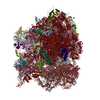
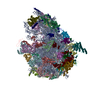


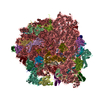
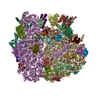
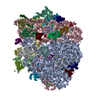
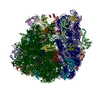
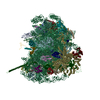

 PDBj
PDBj
































